Needle Buying Guide
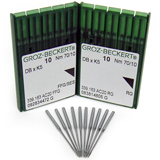
Needle Buying Guide
Our needle guide focuses on four things--needle systems, points, sizes, and premium features. Systems define which machines can use a needle; points let you sew different kinds of materials, sizes determine hole sizes and thread sizes, and premium features are upgrades for specific sewing tasks. There are over 2,300 different Groz-Beckert needles and we sell all of them. Finding your needle is easy. Enter a needle system in the search box at the top and we will take you to your needle. Use the Groz-Beckert system or a competitor's system. Everything is cross-referenced. Use our Groz-Beckert Publications Library for in depth needle information. We have over twenty brochures online.
Information Topics
Needle Systems
- Finding the Right Needle System - Finding the right needle system to fit your sewing machine.
- Reading Needle Labels - Interpreting labeling on packages of needles.
- Home Sewing Needles - All major brands use needle system 130/705 - Equivalent to HAx1, and 15x1.
Needle Points
-
Cloth and Vinyl Points - Explains differences between different points used for cloth and vinyl.
-
Leather Points - Explains different types of points available for machine sewing leather.
Needle Sizes
Premium Needles
Important Notes - System Specific
Needle Systems
Every machine is designed to work with specific types of needles called Needle Systems. Needle buying starts with knowing which needle system works with your machine. Get this from your machine's manual or dealer, or the needle's packaging.
Finding the Right Needle System
Our Sewing Machine Needle Use Guide lists needle systems for over 2,500 sewing machine models from over 25 manufacturers. Manufacturers use different codes to refer to the same needle system. We simplify this by cross-referencing these codes for our search box. For example, entering 15x1 or HAx1 gets the same results. The industry is also inconsistent in the way it formats needle system codes. For example, 15x1 is sometimes entered as 15 x 1. We use Groz-Beckert's exact needle system formatting and allow for common formatting variations in our searches. Most Groz-Beckert packages have a 6 digit identifier that begins with 7, and end with 2. This may be helpful if you already have a pack of Groz-Beckert needles, and you need more.
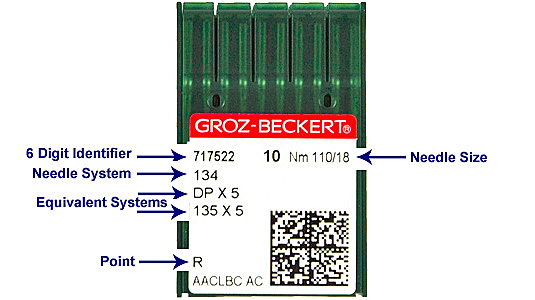
Almost all sewing machines designed for home (or domestic) use take the same flat shank needle system. It is called 130/705, HAx1, or 15x1 depending on the manufacturer. This system works with home sewing machines made by Bernina, Brother, Elna, Husqvarna, Janome, Juki, Melco, Necchi, Baby Lock, New Home, Pfaff, Poem, Riccar, Simplicity, Singer, Viking, and White. Most home sewing machines take up to needle size 100/16. Heavier duty home sewing machines can take up to size 110/18. There are larger 130/705 needles for use in heavy-duty shoe patcher machines.
Needle Points
Most needle systems have needles with several kinds of points. The "right" point depends on the material you are sewing and the way you want stitches to look. Needle points are divided into two groups:
- Cloth and Vinyl Points
- Leather Points
Cloth points make round holes by pushing through fabrics. The R point also known as a Universal Round Point is the most common, and is also used for soft clothing leather. There are many other points that may be better suited to get the desired look.
R Point Needles
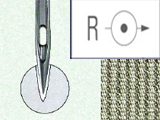
R point needles are also known as Universal, or Universal Round Point needles. They are are a great general purpose type needle, and are the standard lockstitch point. They are used with woven fabrics, coated woven fabrics, artificial leather and soft leather used for clothing. Applications include upper and outer wear, leather accessories, and upholstery. They are also called SET, RD points.
RS Point Needles
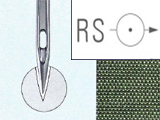
RS point needles have sharp, round points. They are the standard for blindstitches, and are also used for very straight lockstitch seams in fine wovens and Schiffli embroidery. Applications also include blouses, fine skirts, trousers, and curtains. They are also called R-SPI, S SET, and SPI points.
RG Point Needles
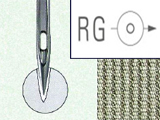
RG point needles have a round point with a small ball point. They are the standard for chain stitches and multihead embroidery. Use on fine delicate knit fabrics, microfibers, woven fabrics, sewing buttons, embroidering soft clothing leather. Applications include shirts, trousers, garments, and chainstitched automobile fabrics. They are also called STU, STUB, S BALL, and SET RT points
FFG Point Needles
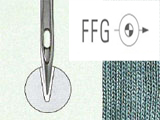
FFG point needles have a light ball point for knit fabrics, cotton fabrics, synthetic fabrics. They are designed to displace loops to avoid material damage. They are perfectly suited for jersey and tricot fabrics. Applications include t-shirts, underwear, sweaters, and some automobile upholstery. Also called SES, L BALL, J BALL, SIN, NYR, and BPL.
FG Point Needles
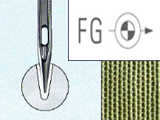
FG point needles are medium ball point needles used for loose-knit fabrics and fabrics with rubber or elastomer content. Applications include pullovers, lace, curtains, and foundation garments. Also called SUK, B BALL, M BALL and SI.
G Point Needles
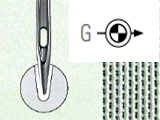
G point needles are heavy ball point needles used for very coarse, highly elastic, and open structured fabrics. Applications include sweaters and cardigans. Also called SKF, H BALL, U BALL, and Y BALL.
SKL Point Needles
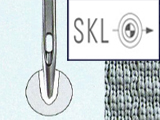
SKL point needles are special ball point needles used for warp fabrics with high elastomer content such as foundation garments and orthopedic cloths.
TR Point Needles
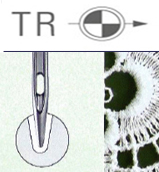
TR point needles have a special ball point used for Schiffli embroidery in open structure fabrics and tulle made from cotton or synthetic fabrics. Applications include lace, drapes, tablecloths, and napkins.
Leather points cut holes in leather, synthetics and cardboard that are more noticeable. Leather needles come in wedge and triangular points that affect stitch appearance. Universal round point (R point) needles are often used in soft clothing leather. Although vinyl is often closely associated with leather, R point needles are recommended.
LR Point Needles
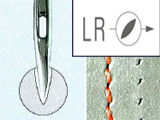
LR point needles have narrow reverse twist points that cut leather at a 45-degree angle slanted to the right. Stitch holes easily visible and thread slightly elevated. They are used with virtually all types of leather for decorative lockstitch seams. Applications include shoes, leather garments, upholstered furniture, belts, car seats. They are also called NRTW and RTW points.
LL Point Needles
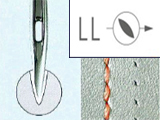
LL point needles have narrow twist points that cut leather at a 45-degree angle slanted to the left. Seams are very straight and thread is slightly elevated. They are used with virtually all types of leather in applications such as shoes, bags, and car seats. They are also called NTW and TW points.
P Point Needles
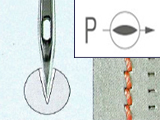
P point needles cut leather perpendicular to the sewing direction. This creates a prominent decorative seams with deep set stitches on thick and hard leather such as shoes, belts, and upholstery. It is also called a narrow wedge, NW, point.
PCL Point Needles
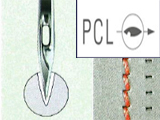
PCL point needles cut leather perpendicular to the sewing direction. This creates a prominent decorative seams with deep set stitches on thick and hard leather such as shoes, belts, and upholstery. It is also used for stay seams and heel seams. It is also called a narrow wedge, NWLT, point.
S Point Needles
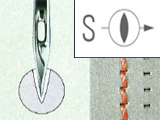
S point needles cut leather in the sewing direction producing a straight seam in medium to hard leather and is used for shoes, leather clothing, and bags. The SAN 12 version is designed for two-needle machines and is used for automobile interiors seats and headrests as well as upholstered furniture. It is also called a narrow cross (NCR) point.
D Point Needles
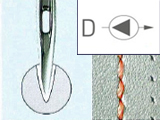
D point needles have triangular points that cut a triple-edge hole in leather, and produce straight seams with the thread slightly elevated. They are used with hard thick leather, synthetics and cardboard in applications such as belts, suit cases, and shoes. They are also called TRI points.
DH Point Needles
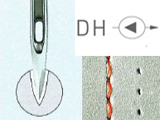
DH point needles have triangular points that cut a medium triple edge hole in leather. They are used for medium-hard and hard leather and synthetics in applications such as upholstery, bags, shoes, tarps, awnings, and tents.
SD Point Needles
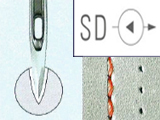
SD point needles have round points with triple cutting edges at the very end of the point that produce straight seams with slightly elevated stitches. They are used with soft clothing leather, plastic, and laminates in applications such as shoes, fine leather, leather embroidery, and foils.
Needle Sizes
A needle's size refers to the thickness of the needle's blade. We show each metric and U.S. (Singer) sizes for all needles.
A larger size number means:
- A heavier, stronger needle
- A larger eye that allows heavier, stronger, more visible thread
- Larger needle holes in the sewn material
Generally, the best needle size is the one that is just large enough for the thread to go through its eye and keep holes as small as possible. But, there are other considerations such as decorative "look", the need to sew through layers of material, and the capabilities of your machine. Our Needle Size Chart shows Groz-Beckert needle sizes and the range of thread sizes used with each needle.
Premium Needles
Some Groz-Beckert needles have premium features that improve their performance. They cost more, but the difference is worth it.
GEBEDUR--Titanium nitride coated needles that are twice as hard as chromium and last longer. This cuts down time for needle changes, reduces skipped stitches and thread breakage, and results in less material damage. GEBEDUR needles correspond to other manufacturers PD and TN designations. See GEBEDUR Needles a Revolution In Gold for more information.
MR and SAN 11 - Multi range needles have a special blade and scarf shape that makes it extremely resistant to bending. This reduces costs by having fewer skipped stitches and thread breakage, allowing extremely tight adjustment of hook to needle, and reducing fabric damage. See The Special Application Needle MR, and MR and Loop Control Needles for Long Arm Quilting Machines for more information.
SAN 1 and Embroidery - Needles designed for single head and multi head embroidery. See Needles for Single and Multi Head Embroidery for more information
SAN 5 - Needles designed for technical textiles used in areas such as agriculture, building, clothing, and automotive. They give improved stability, fewer skipped stitches, and more uniform seams. See Special Application Needle San 5 for more information.
SAN 6 - These needles are designed for sewing jeans and other thick materials at high speeds. Their special shape reduces needle deflection. See Special Application SAN 6 for more information.
SAN 10 and SAN 10 XS - These needles are designed for fabrics that are easily damaged such as fine knits, very delicate fabrics, textured yarns and elastic yarns. Use the SAN 10 XS needles for extremely delicate materials. See The Right Needle for more information.
SAN 12 - Needles designed for sewing uniform looking 2-needle decorative seams on leather such as automobile upholstery. The come with LR points for slanted stitches and S points for straight stitches. See Special Application Needle LR - SAN 12 for more information.
Note - Groz-Beckert SAN needles are called SERV and NY2 needles by other manufacturers
Important Notes - System Specific
There are occasionally instances where the needle point, needle size, or both affect the needle system designation. Here are the most common exceptions that occur with some of the following needle systems:
-
DBx1
The DBx1 needle system has a shank diameter of 1.63 mm up to size 110/18. DBx1 needle sizes above 110/18 have larger shank diameter at 2.00 mm and become system 134. In order to continue with the 1.63 mm shank diameter in the larger needle sizes, you will need to change the system to a 1738A. -
135x16 and 135x17
135x16 and 135x17 needle systems are interchangeable. 135x16 are leather point needles, and 135x17 are cloth point needles.